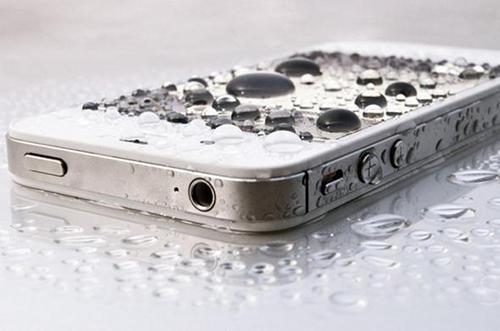
Whether you’re an iOS, Android, Windows Phone, or BlackBerry fan, we can all agree that we’re all probably excited about some of the devices we’re hoping to see release this year. Better cameras, faster processors, and enhanced features are always something to look forward to. However, all of those functions become completely useless once the device is exposed to a little too much moisture.
It was always tough being presented with a situation in a retail setting that involved “liquid damage”. One of the protocols we had to do when prompted with a glitchy device was to remove the back door and the battery, then check the liquid damage indicator. Should the indicator show up red, there’s not much we can do beyond the dreaded hard reset and the shrug of our shoulders – if we sent the device back for replacement, the insurance company needs to see the condition of the indicator. If we lied and said that everything checked out in order to save the customer any replacement fee, it could cost us our jobs. The problem was, most of the time the owner had no idea their device had been exposed to any liquids.
Liquid damage to a device is one of the most common factors that play into why our devices start to have issues, and it’s also a term that should be taken very loosely. I don’t know about you, but when I first heard the term “liquid damage” my mind automatically thought of a phone being absentmindedly dipped in milk when the dunker meant to grab an Oreo instead, or a swimmer just remembering their device was in the pocket of their swimming trunks mid-dive. You know; large scale things. Come to find out “liquid damage” can mean any type of liquid damage – even exposure to too much humidity can turn that wretched indicator red.
This is something we’ve been battling since, well, the beginning of electronics. It’s a known fact that electricity and water just don’t mix. While there are situations that are doomed from the get-go (milk dunking, dropped at the bottom of the lake, etc.) there are some situations I feel are so minor that there should be something we can do to change the black and white responses we get from companies.
There are a lot of minor ways that can result in liquid damage on a device. Many people use their phones while exercising since they also make convenient media players. Of course, when it comes to exercising the point is to break a sweat, and when you break a sweat, your device (which is presumably close to your body) becomes at risk for liquid damage. Or say you’re outside enjoying the presumably nice weather, and all of the sudden some rain storm comes in and ruins your day – and possibly your phone, too, because all you have to protect it is the pocket of your jeans. Little things like that that either shouldn’t be counted when it comes to the cost of a replacement, or perhaps the way indicators read should be a little different.
Liquid damage indicators generally only turn one color: red. It can be partially red (which is usually how you can tell when it was really a case of something minor) or really red, which generally means a lot of potential damage is being caused by whatever incident involved the liquid contact. Regardless, any red seen on the indicator basically means you are out of luck and will need to pay a pretty penny to get a new device. I think this is where the rules need to change.
I think the indicators need to feature different levels of color so companies can at least supply different tiers of replacement fees depending on the amount of liquid damage. Clearly there’s not going to be any foolproof way of determining how a person’s phone got wet, but if the phone still turns on and only has a few issues, I don’t think they should necessarily have to pay the same price as somebody whose phone is completely drenched and now own a phone that no longer works at all. Mo' damage, mo' problems.
I hated the cases where I got that customer who was at their wits end because they couldn’t get anywhere within the company due to a small red splotch on the indicator, and I didn't hate the cases because the customer was frustrated; it was because there was literally nothing I could do for them that wouldn’t make me a prime target for losing my job because of it. I feel like some changes in how liquid damage situations are dealt with can help at least a few people walk out of the store happy. I don’t agree with the “all or nothing” policy that I’ve experienced with some companies.
Readers, what do you think? Do you think that a liquid damaged device deserves to be condemned no matter what happened, or that there should be different protocol for different amounts of damage? Have you ever been surprised to find out your device had liquid damage? Let me know what you think in the comments!